5.4 Adulthood
How old does a person have to be before you think of him or her as old? Depends on who you ask. For 18- to 29-year-olds, 67 was old. For those 60 and over, old was 76 (Yankelovich, 1995).
“I am still learning.”
Michelangelo, 1560, at age 85
The unfolding of people’s adult lives continues acoss the life span. It is, however, more difficult to generalize about adulthood stages than about life’s early years. If you know that James is a 1-year-old and Jamal is a 10-year-old, you could say a great deal about each child. Not so with adults who differ by a similar number of years. The boss may be 30 or 60; the marathon runner may be 20 or 50; the 19-year-old may be a parent who supports a child or a child who receives an allowance. Yet our life courses are in some ways similar. Physically, cognitively, and especially socially, we differ at age 50 from our 25-year-old selves. In the discussion that follows, we recognize these differences and use three terms: early adulthood (roughly twenties and thirties), middle adulthood (to age 65), and late adulthood (the years after 65). Within each of these stages, people will vary widely in physical, psychological, and social development.
214
Physical Development
5-17 What physical changes occur during middle and late adulthood?
Like the declining daylight after the summer solstice, our physical abilities—muscular strength, reaction time, sensory keenness, and cardiac output—all begin an almost imperceptible decline in our mid-twenties. Athletes are often the first to notice. World-class sprinters and swimmers peak by their early twenties. Baseball players peak at about age 27—with 60 percent of Most Valuable Player awardees since 1985 coming ±2 years of that (Silver, 2012). Women—who mature earlier than men—peak earlier. But most of us—especially those of us whose daily lives do not require top physical performance—hardly perceive the early signs of decline.

Physical Changes in Middle Adulthood
menopause the time of natural cessation of menstruation; also refers to the biological changes a woman experiences as her ability to reproduce declines.
Post-40 athletes know all too well that physical decline gradually accelerates. As a lifelong basketball player, I [DM] have found myself increasingly not racing for that loose ball. But even diminished vigor is sufficient for normal activities. Moreover, during early and middle adulthood, physical vigor has less to do with age than with a person’s health and exercise habits. Many of today’s physically fit 50-year-olds run four miles with ease, while sedentary 25-year-olds find themselves huffing and puffing up two flights of stairs.
Aging also brings a gradual decline in fertility, especially for women. For a 35- to 39-year-old woman, the chance of getting pregnant after a single act of intercourse is only half that of a woman 19 to 26 (Dunson et al., 2002). Men experience a gradual decline in sperm count, testosterone level, and speed of erection and ejaculation. Women experience menopause, as menstrual cycles end, usually within a few years of age 50. Expectations and attitudes influence the emotional impact of this event. Is it a sign of lost femininity and growing old, or liberation from menstrual periods and fears of pregnancy? For men, too, expectations influence perceptions. Some experience distress related to a perception of declining virility and physical capacities, but most age without such problems.

With age, sexual activity lessens. Nearly 9 in 10 Americans in their late twenties reported having had vaginal intercourse in the past year, compared with 22 percent of women and 43 percent of men who were over 70 (Herbenick et al., 2010; Reece et al., 2010). Nevertheless, most men and women remain capable of satisfying sexual activity, and most express satisfaction with their sex life. This was true of 70 percent of Canadians surveyed (ages 40 to 64) and 75 percent of Finns (ages 65 to 74) (Kontula & Haavio-Mannila, 2009; Wright, 2006). In one survey, 75 percent of respondents reported being sexually active into their 80s (Schick et al., 2010). And in an American Association of Retired Persons sexuality survey, it was not until age 75 or older that most women and nearly half of men reported little sexual desire (DeLamater, 2012; DeLamater & Sill, 2005). Given good health and a willing partner, the flames of desire, though simmered down, live on. As Alex Comfort (1992, p. 240) jested, “The things that stop you having sex with age are exactly the same as those that stop you riding a bicycle (bad health, thinking it looks silly, no bicycle).”
Physical Changes in Late Adulthood
Is old age “more to be feared than death” (Juvenal, Satires)? Or is life “most delightful when it is on the downward slope” (Seneca, Epistulae ad Lucilium)? What is it like to grow old?
“I intend to live forever—so far, so good.”
Comedian Steven Wright
Life Expectancy From 1950 to 2011, life expectancy at birth increased worldwide from 46.5 years to 70 years—and to 80 and beyond in some developed countries (WHO, 2014a,b). What a gift—two decades more of life! In China, the United States, Britain, Canada, and Australia (to name some countries where students read this book), life expectancy has risen to 76, 79, 80, 82, and 82 respectively (WHO, 2014). This increasing life expectancy (humanity’s greatest achievement, say some) combines with decreasing birthrates: Older adults are a bigger and bigger population segment, creating an increasing demand for hearing aids, retirement villages, and nursing homes. Today, 1 in 10 people worldwide are 60 or older. The United Nations (2001, 2010) projects that number will double to 2 in 10 by 2050 (and to nearly 4 in 10 in Europe).
215
Throughout the life span, males are more prone to dying. Although 126 male embryos begin life for every 100 females, the sex ratio is down to 105 males for every 100 females at birth (Strickland, 1992). During the first year, male infants’ death rates exceed females’ by one-fourth. Worldwide, women outlive men by 4.6 years (WHO, 2014b). (Rather than marrying a man older than themselves, 20-year-old women who want a husband who shares their life expectancy should wait for the 16-year-old boys to mature.) By age 100, women outnumber men 5 to 1.
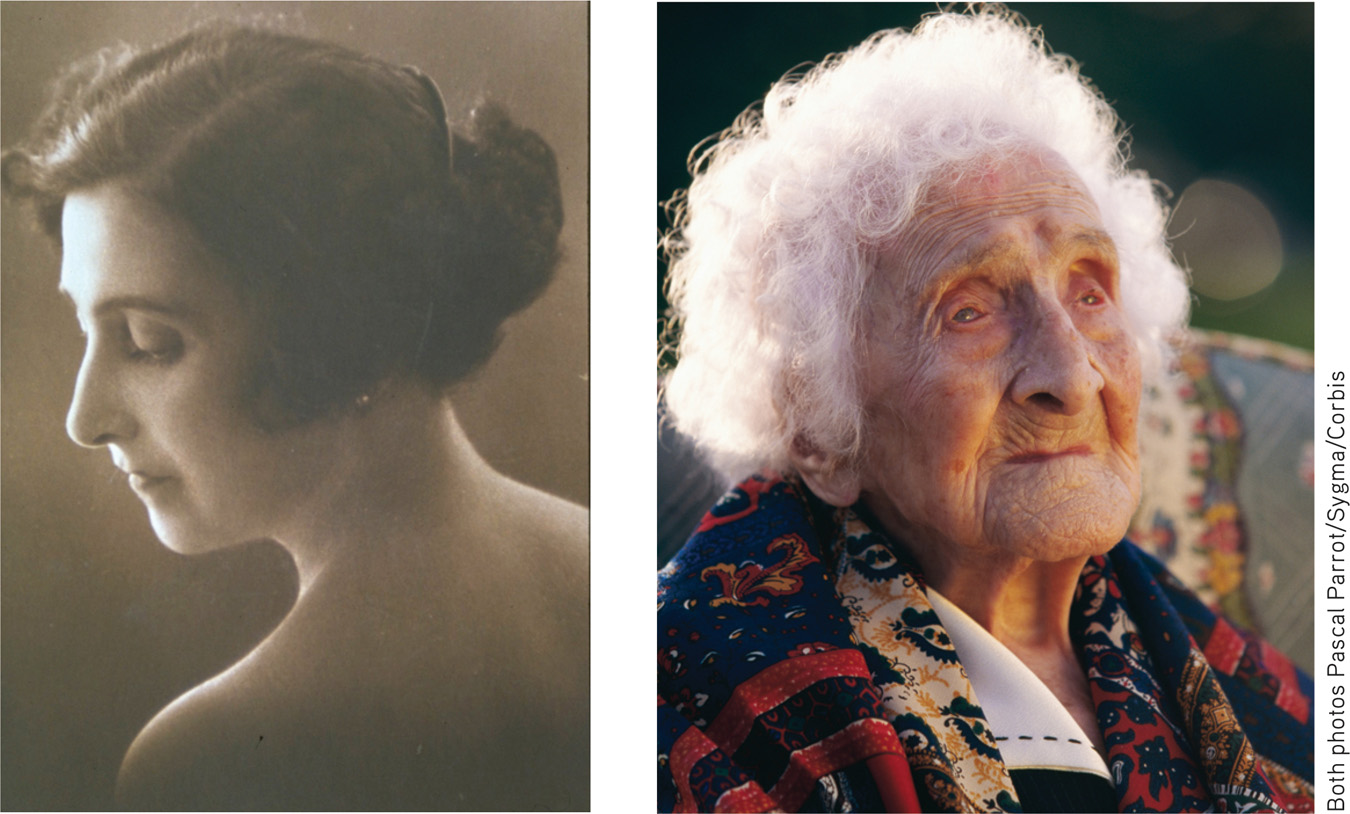
But few of us live to 100. Disease strikes. The body ages. Its cells stop reproducing. It becomes frail and vulnerable to tiny insults—hot weather, a fall, a mild infection—that at age 20 would have been trivial. Tips of chromosomes, called telomeres, wear down, much as the tip of a shoelace frays. This wear is accelerated by smoking, obesity, or stress. Children who suffer frequent abuse or bullying exhibit shortened telomeres as biological scars (Shalev et al., 2013). As telomeres shorten, aging cells may die without being replaced with perfect genetic replicas (Epel, 2009).
Low stress and good health habits enable longevity, as does a positive spirit. Chronic anger and depression increase our risk of premature death. Researchers have even observed an intriguing death-deferral phenomenon (Shimizu & Pelham, 2008). Across one 15-year-period, the 82,000 deaths on Christmas Day rose to 85,000 on December 26 and 27. The death rate also increases when people reach their birthdays, and when they survive until after other milestones, like the first day of the new millennium.
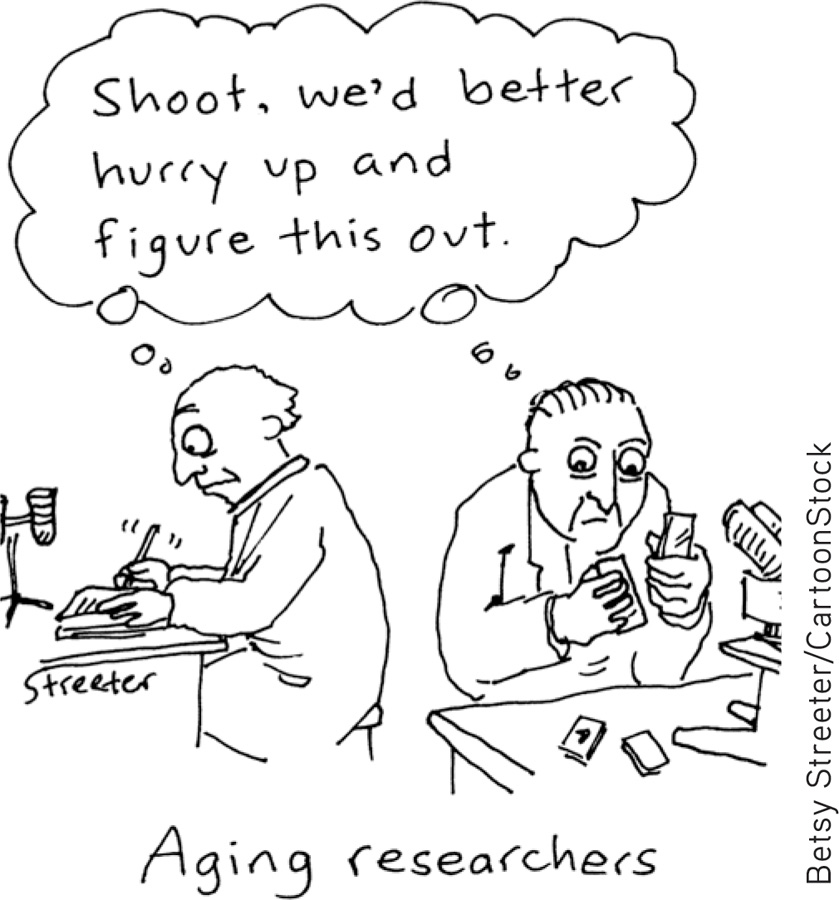
Sensory Abilities, Strength, and Stamina Although physical decline begins in early adulthood, we are not usually acutely aware of it until later life, when the stairs get steeper, the print gets smaller, and other people seem to mumble more. Visual sharpness diminishes, and distance perception and adaptation to light-level changes are less acute. Muscle strength, reaction time, and stamina also diminish, as do the senses of smell and hearing. In Wales, teens’ loitering around a convenience store has been discouraged by a device that emits an aversive high-pitched sound that almost no one over 30 can hear (Lyall, 2005).
“For some reason, possibly to save ink, the restaurants had started printing their menus in letters the height of bacteria.”
Dave Barry, Dave Barry Turns Fifty, 1998
With age, the eye’s pupil shrinks and its lens becomes less transparent, reducing the amount of light reaching the retina. A 65-year-old retina receives only about one-third as much light as its 20-year-old counterpart (Kline & Schieber, 1985). Thus, to see as well as a 20-year-old when reading or driving, a 65-year-old needs three times as much light—a reason for buying cars with untinted windshields. This also explains why older people sometimes ask younger people, “Don’t you need better light for reading?”
Most stairway falls taken by older people occur on the top step, precisely where the person typically descends from a window-lit hallway into the darker stairwell (Fozard & Popkin, 1978). Our knowledge of aging could be used to design environments that would reduce such accidents (National Research Council, 1990).
Health As people age, they care less about what their bodies look like and more about how they function. For those growing older, there is both bad and good news about health. The bad news: The body’s disease-fighting immune system weakens, making older adults more susceptible to life-threatening ailments such as cancer and pneumonia. The good news: Thanks partly to a lifetime’s accumulation of antibodies, people over 65 suffer fewer short-term ailments, such as common flu and cold viruses. One study found they were half as likely as 20-year-olds and one-fifth as likely as preschoolers to suffer upper respiratory flu each year (National Center for Health Statistics, 1990).
216
The Aging Brain Up to the teen years, we process information with greater and greater speed (Fry & Hale, 1996; Kail, 1991). But compared with teens and young adults, older people take a bit more time to react, to solve perceptual puzzles, even to remember names (Bashore et al., 1997; Verhaeghen & Salthouse, 1997). The neural processing lag is greatest on complex tasks (Cerella, 1985; Poon, 1987). At video games, most 70-year-olds are no match for a 20-year-old. And, as FIGURE 5.21 indicates, fatal accident rates per mile driven increase sharply after age 75. By age 85, they exceed the 16-year-old level. Older drivers appear to focus well on the road ahead, but attend less to other vehicles approaching from the side (Pollatsek et al., 2012). Nevertheless, because older people drive less, they account for fewer than 10 percent of crashes (Coughlin et al., 2004).
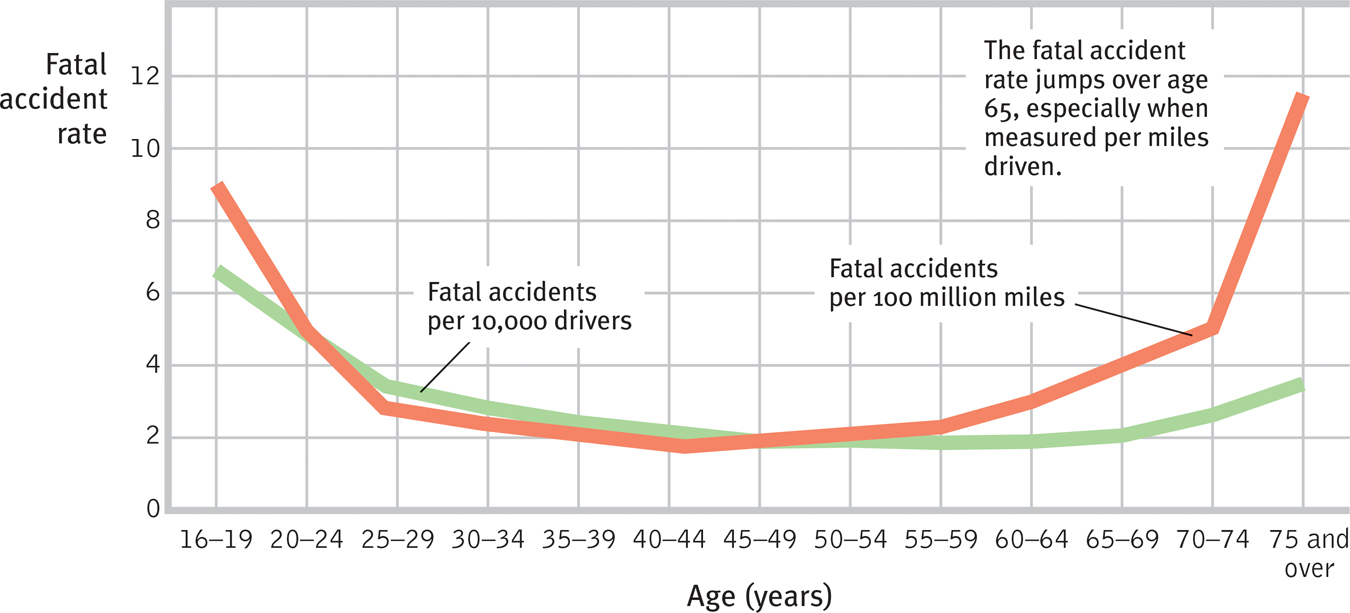
 Figure 5.21
Figure 5.21Age and driver fatalities Slowing reactions contribute to increased accident risks among those 75 and older, and their greater fragility increases their risk of death when accidents happen (NHTSA, 2000). Would you favor driver exams based on performance, not age, to screen out those whose slow reactions or sensory impairments indicate accident risk?
Even speech slows (Jacewicz et al. 2009). One research team compared speeches of the renowned psychologist, B. F. Skinner, and observed his speaking rate at ages 58, 73, and 90 as 148, 137, and 106 words per minute, respectively (Epstein, 2012).
Brain regions important to memory begin to atrophy during aging (Schacter, 1996). No wonder older adults, after taking a memory test, feel older: “aging 5 years in 5 minutes,” jested one research report (Hughes et al., 2013). In early adulthood, a small, gradual net loss of brain cells begins, contributing by age 80 to a brain-weight reduction of 5 percent or so. Earlier, we noted that late-maturing frontal lobes help account for teen impulsivity. Late in life, atrophy of the inhibition-controlling frontal lobes seemingly explains older people’s occasional blunt questions and comments (“Have you put on weight?”) (von Hippel, 2007). But good news: The aging brain is plastic, and partly compensates for what it loses by recruiting and reorganizing neural networks (Park & McDonough, 2013). During memory tasks, for example, the left frontal lobes are especially active in young adult brains, while older adult brains use both left and right frontal lobes.
EXERCISE AND AGING And more good news: Exercise slows aging. Active older adults tend to be mentally quick older adults. Physical exercise not only enhances muscles, bones, and energy and helps prevent obesity and heart disease, it maintains the telomeres that protect the chromosome ends (Leslie, 2011).
Exercise also stimulates brain cell development and neural connections, thanks perhaps to increased oxygen and nutrient flow (Erickson et al., 2013; Pereira et al., 2007). Sedentary older adults randomly assigned to aerobic exercise programs exhibit enhanced memory, sharpened judgment, and reduced risk of significant cognitive decline (DeFina et al., 2013; Liang et al., 2010; Nagamatsu et al., 2013). In aging brains, exercise reduces brain shrinkage (Gow et al., 2012). It promotes neurogenesis (the birth of new nerve cells) in the hippocampus, a brain region important for memory (Cherkas et al., 2008; Erickson, 2009; Pereira et al., 2007). And it increases the cellular mitochondria that help power both muscles and brain cells (Steiner et al., 2011). We are more likely to rust from disuse than to wear out from overuse. Fit bodies support fit minds.
217
Cognitive Development
Aging and Memory
5-18 How does memory change with age?
Among the most intriguing developmental psychology questions is whether adult cognitive abilities, such as memory, intelligence, and creativity, parallel the gradually accelerating decline of physical abilities.
As we age, we remember some things well. Looking back in later life, adults asked to recall the one or two most important events over the last half-century tend to name events from their teens or twenties (Conway et al., 2005; Rubin et al., 1998). They also display this “reminiscence bump” when asked to name their all-time favorite music, movies, and athletes (Janssen et al., 2011). Whatever people experience around this time—World War II, the 9/11 terrorist attacks, the election of the first U.S. Black president—becomes pivotal (Pillemer, 1998; Schuman & Scott, 1989). In our teens and twenties are so many memorable “firsts”—first kiss, first job, first day at college or university, first meeting in-laws.
Early adulthood is indeed a peak time for some types of learning and remembering. In one test of recall, people watched video clips as 14 strangers said their names, using a common format: “Hi, I’m Larry” (Crook & West, 1990). Then those strangers reappeared and gave additional details. For example, they said, “I’m from Philadelphia,” providing more visual and voice cues for remembering the person’s name. As FIGURE 5.22 shows, after a second and third replay of the introductions, everyone remembered more names, but younger adults consistently surpassed older adults.
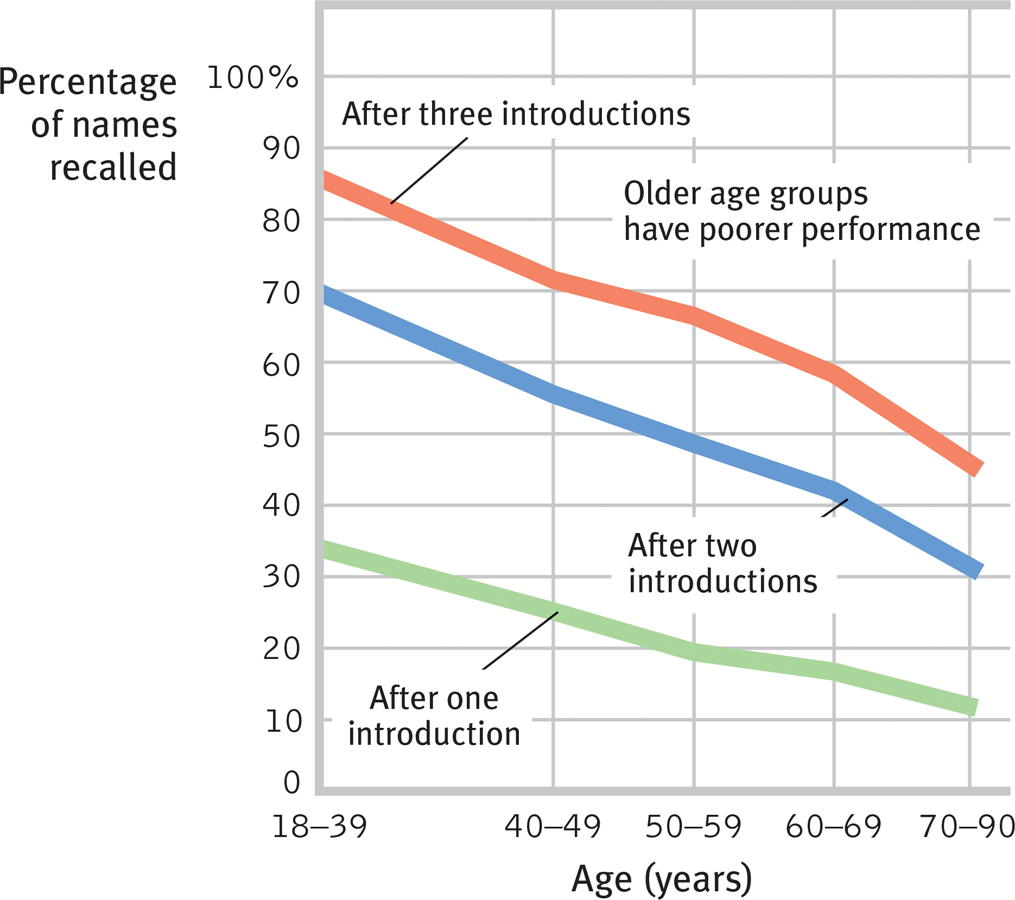
 Figure 5.22
Figure 5.22Tests of recall Recalling new names introduced once, twice, or three times is easier for younger adults than for older ones. (Data from Crook & West, 1990.)
Perhaps it is not surprising, then, that nearly two-thirds of people over age 40 have said their memory is worse than it was 10 years ago (KRC, 2001). In fact, how well older people remember depends on the task. In another experiment, when asked to recognize 24 words they had earlier tried to memorize, people showed only a minimal decline in memory. When asked to recall that information without clues, the decline was greater (FIGURE 5.23).
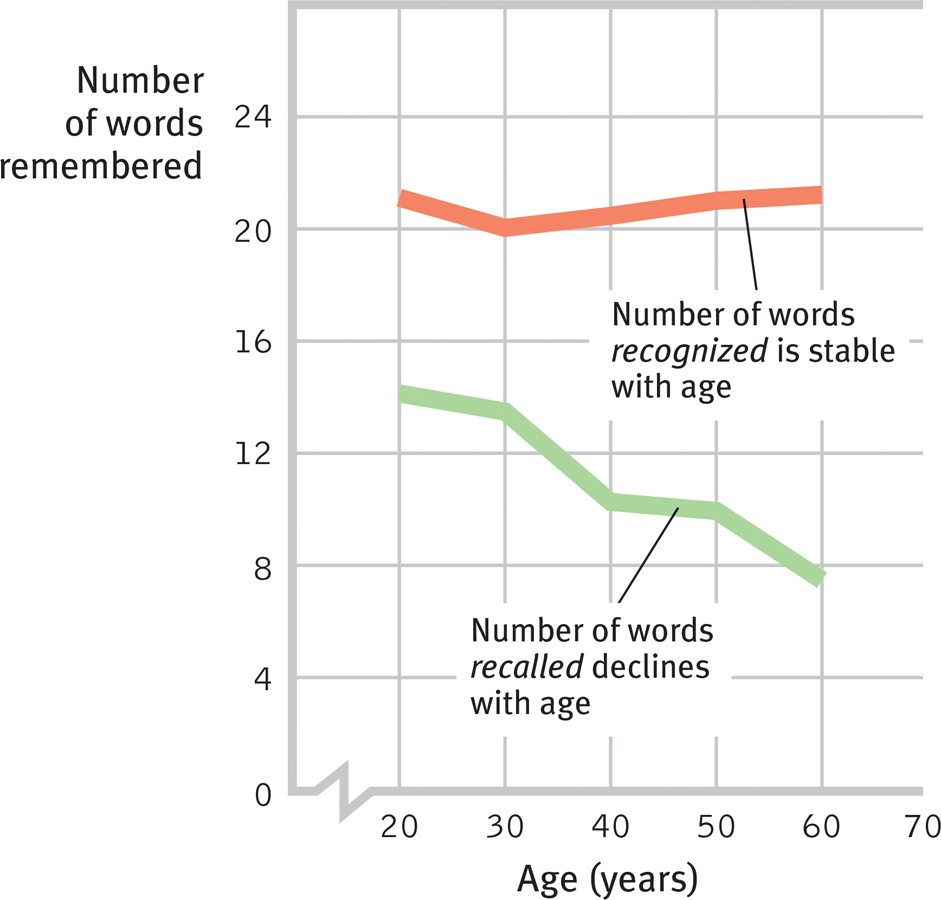
 Figure 5.23
Figure 5.23Recall and recognition in adulthood In this experiment, the ability to recall new information declined during early and middle adulthood, but the ability to recognize new information did not. (Data from Schonfield & Robertson, 1966.)
Teens and young adults surpass both young children and 70-year-olds at prospective memory (“Remember to …”) (Zimmerman & Meier, 2006). But older people’s prospective memory remains strong when events help trigger a memory (as when walking by a convenience store triggers “Pick up milk!”). Time-based tasks (“Client meeting at 3:00 p.m.”) and especially habitual tasks (“Take medications at 9:00 a.m., 2:00 p.m., and 6:00 p.m.”) can be challenging (Einstein et al., 1990, 1995, 1998). To minimize such problems, older adults rely more on time management and reminder cues, such as notes to themselves (Henry et al., 2004). This might have helped John Basinger, who, at age 76, was to be interviewed by a local paper regarding a psychology journal article on his late-life memorization of all 12 volumes of John Milton’s epic poem Paradise Lost (Seamon et al., 2010; Weir, 2010). He forgot a scheduled meeting with the reporter. When calling to apologize, he noted the irony of forgetting his interview about memory.
In our capacity to learn and remember, as in other areas of development, we differ. Younger adults vary in their abilities to learn and remember, but 70-year-olds vary much more. “Differences between the most and least able 70-year-olds become much greater than between the most and least able 50-year-olds,” reported Oxford researcher Patrick Rabbitt (2006). Some 70-year-olds perform below nearly all 20-year-olds; other 70-year-olds match or outdo the average 20-year-old.
No matter how quick or slow we are, remembering seems also to depend on the type of information we are trying to retrieve. If the information is meaningless—nonsense syllables or unimportant events—then the older we are, the more errors we are likely to make. If the information is meaningful, as was Paradise Lost for John Basinger, older people’s rich web of existing knowledge will help them to hold it. But they may take longer than younger adults to produce the words and things they know. Older adults also more often experience memories on the tip-of-the-tongue (Ossher et al., 2012). Quick-thinking game show winners have usually been young or middle-aged adults (Burke & Shafto, 2004).
218
Psychologists who study the aging mind have been debating whether “brain fitness” computer training programs can build mental muscles and stave off cognitive decline. Given what we know about the brain’s plasticity, can exercising our brains on a “cognitive treadmill”—with memory, visual tracking, and problem-solving exercises—avert losing our minds? “At every point in life, the brain’s natural plasticity gives us the ability to improve … function,” said one neuroscientist-entrepreneur (Merzenich, 2007). One five-year study of nearly 3000 people found that 10 one-hour cognitive training sessions, with follow-up booster sessions a year (and more later), led to improved cognitive scores on tests related to their training (Boron et al., 2007; Willis et al., 2006). Other studies with children and adults also found that brain training that exercises working memory can sharpen the mind (Anguera et al., 2013; Jonides et al., 2012).
Based on such findings, some computer game makers are marketing daily brain-exercise programs for older adults. But other researchers, after reviewing all the available studies, advise caution (Melby-Lervåg & Hulme, 2013; Redick et al., 2013; Salthouse, 2010; Shipstead et al., 2012a,b). The available evidence, they argue, suggests that brain training can produce short-term gains, but only on the trained tasks (Berkman et al., 2014; Harrison et al., 2013). A British study of 11,430 people, who either completed brain training activities over six weeks or a control task, confirmed the limited benefits. Although the training improved the practiced skills, it did not boost overall cognitive fitness (Owen et al., 2010).
If you are within five years of 20, what experiences from the past year will you likely never forget? (This is the time of your life you may best remember when you are 50.)
cross-sectional study a study in which people of different ages are compared with one another.
longitudinal study research in which the same people are restudied and retested over a long period.
Chapter 10 explores another dimension of cognitive development: intelligence. As we will see, cross-sectional studies (comparing people of different ages) and longitudinal studies (restudying people over time) have identified mental abilities that do and do not change as people age. Age is less a predictor of memory and intelligence than is proximity to death. Tell me whether someone is 8 months or 8 years from a natural death and, regardless of age, you’ve given me a clue to that person’s mental ability. In the last three or four years of life and especially as death approaches, cognitive decline typically accelerates and negative feelings increase (Vogel et al., 2013; Wilson et al., 2007). Researchers call this near-death drop terminal decline (Backman & MacDonald, 2006).
Neurocognitive Disorders and Alzheimer’s Disease
5-19 How do neurocognitive disorders and Alzheimer’s disease affect cognitive ability?
Most people who live into their nineties do so with clear minds. Some, unfortunately, suffer a substantial loss of brain cells in a process that is not normal aging. A series of small strokes, a brain tumor, or alcohol use disorder can progressively damage the brain, causing that mental erosion we call a neurocognitive disorder (NCD, formerly called dementia). Heavy midlife smoking more than doubles later risk of the disorder (Rusanen et al., 2011). The feared brain ailment Alzheimer’s disease strikes 3 percent of the world’s population by age 75. Up to age 95, the incidence of mental disintegration doubles roughly every 5 years (FIGURE 5.24).

 Figure 5.24
Figure 5.24Incidence of neurocognitive disorders (NCDs) by age The risk of mental disintegration due to Alzheimer’s disease, strokes, or other brain disease increases with age (Brookmeyer et al., 2011). Still, most people who live into their nineties do so with clear minds.
neurocognitive disorders (NCDs) acquired (not lifelong) disorders marked by cognitive deficits; often related to Alzheimer’s disease, brain injury or disease, or substance abuse. In older adults neurocognitive disorders were formerly called dementia.
Alzheimer’s disease a neurocognitive disorder marked by neural plaques, often with an onset after age 80, and entailing a progressive decline in memory and other cognitive abilities.
Alzheimer’s destroys even the brightest of minds. First memory deteriorates, then reasoning. (Occasionally forgetting where you laid the car keys is no cause for alarm; forgetting how to get home may suggest Alzheimer’s.) Robert Sayre (1979) recalled his father shouting at his afflicted mother to “think harder,” while his mother, confused, embarrassed, on the verge of tears, randomly searched the house for lost objects. As the disease runs its course, after 5 to 20 years, the person becomes emotionally flat, then disoriented and disinhibited, then incontinent, and finally mentally vacant—a sort of living death, a mere body stripped of its humanity.
“We’re keeping people alive so they can live long enough to get Alzheimer’s disease.”
Steve McConnell, Alzheimer’s Association Vice President, 2007
219
Underlying the symptoms of Alzheimer’s are a loss of brain cells and a deterioration of neurons that produce the neurotransmitter acetylcholine, which is vital to memory and thinking. An autopsy reveals two telltale abnormalities in these acetylcholine-producing neurons: shriveled protein filaments in the cell body, and clumps of a free-floating protein fragment that accumulate as plaque at neuron tips where synaptic communication normally occurs. Long before its symptoms occur, new technologies can now test for the Alzheimer’s susceptibility gene or check spinal fluid for the culprit protein fragments (De Meyer et al., 2010; Luciano et al., 2009). Such discoveries have stimulated a race to invent and test drugs that may forestall the disease, such as by reducing the activity of a memory inhibiting neurotransmitter, called GABA (Chen et al., 2014). The recent discovery of 21 associated genes may help (Lambert et al., 2013).
A diminishing sense of smell and slowed or wobbly walking may foretell Alzheimer’s (Belluck, 2012; Wilson et al., 2007). Among older adults, hearing loss, and its associated social isolation, predicts risk of depression and accelerated mental decline (Li et al., 2014; Lin et al., 2011a,b, 2013). Compared with people with good hearing, those with hearing loss show declines in memory, attention, and learning about three years earlier. In people at risk for Alzheimer’s, brain scans (FIGURE 5.25) have also revealed—before symptoms appear—the degeneration of critical brain cells and diminished activity in Alzheimer’s-related brain areas (Apostolova et al., 2006; Johnson et al., 2006; Wu & Small, 2006). When people memorized words, scans also showed diffuse brain activity, as if more exertion was required to achieve the same performance (Bookheimer et al., 2000).
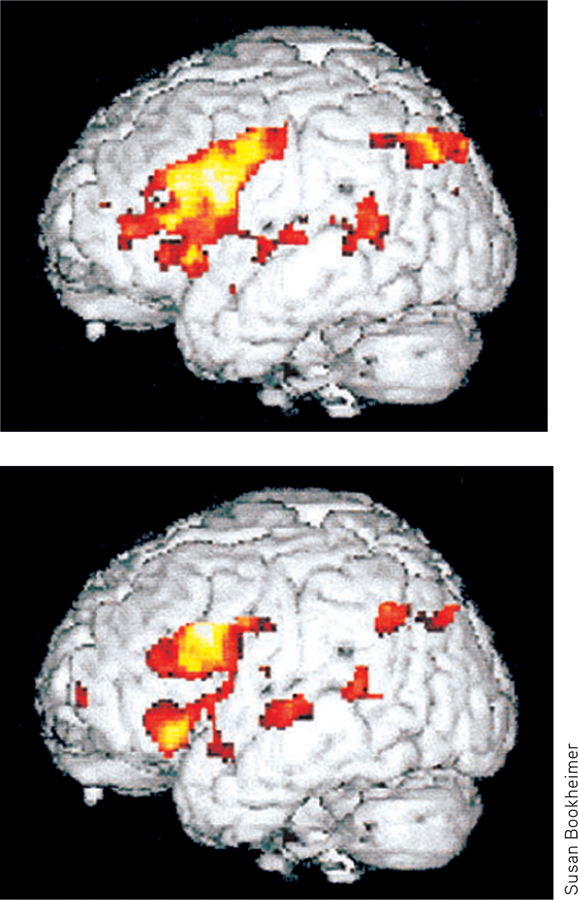
 Figure 5.25
Figure 5.25Predicting Alzheimer’s disease During a memory test, MRI scans of the brains of people at risk for Alzheimer’s (top) revealed more intense activity (yellow, followed by orange and red) when compared with normal brains (bottom). As brain scans and genetic tests make it possible to identify those likely to suffer Alzheimer’s, would you want to be tested? At what age?
Alzheimer’s is somewhat less common among those who exercise their minds as well as their bodies (Agrigoroaei & Lachman, 2011). As with muscles, so with the brain: Those who use it less often lose it.
Social Development
5-20 What themes and influences mark our social journey from early adulthood to death?
Many differences between younger and older adults are created by significant life events. A new job means new relationships, new expectations, and new demands. Marriage brings the joy of intimacy and the stress of merging two lives. The three years surrounding the birth of a child bring increased life satisfaction for most parents (Dyrdal & Lucas, 2011). The death of a loved one creates an irreplaceable loss. Do these adult life events shape a sequence of life changes?
220
Adulthood’s Ages and Stages
As people enter their forties, they undergo a transition to middle adulthood, a time when they realize that life will soon be mostly behind instead of ahead of them. Some psychologists have argued that for many the midlife transition is a crisis, a time of great struggle, regret, or even feeling struck down by life. The popular image of the midlife crisis is an early-forties man who forsakes his family for a younger girlfriend and a hot sports car. But the fact—reported by large samples of people—is that unhappiness, job dissatisfaction, marital dissatisfaction, divorce, anxiety, and suicide do not surge during the early forties (Hunter & Sundel, 1989; Mroczek & Kolarz, 1998). Divorce, for example, is most common among those in their twenties, suicide among those in their seventies and eighties. One study of emotional instability in nearly 10,000 men and women found “not the slightest evidence” that distress peaks anywhere in the midlife age range (McCrae & Costa, 1990).
For the 1 in 4 adults who report experiencing a life crisis, the trigger is not age, but a major event, such as illness, divorce, or job loss (Lachman, 2004). Some middle-aged adults describe themselves as a “sandwich generation,” simultaneously supporting their aging parents and their emerging adult children or grandchildren (Riley & Bowen, 2005).
“The important events of a person’s life are the products of chains of highly improbable occurrences.”
Joseph Traub, “Traub’s Law,” 2003
social clock the culturally preferred timing of social events such as marriage, parenthood, and retirement.
Life events trigger transitions to new life stages at varying ages. The social clock—the definition of “the right time” to leave home, get a job, marry, have children, and retire—varies from era to era and culture to culture. The once-rigid sequence has loosened; the social clock still ticks, but people feel freer about being out of sync with it.
Even chance events can have lasting significance, by deflecting us down one road rather than another. Albert Bandura (1982, 2005) recalls the ironic true story of a book editor who came to one of Bandura’s lectures on the “Psychology of Chance Encounters and Life Paths”—and ended up marrying the woman who happened to sit next to him. The sequence that led to my [DM] authoring this book (which was not my idea) began with my being seated near, and getting to know, a distinguished colleague at an international conference. Chance events can change our lives.
Adulthood’s Commitments
Two basic aspects of our lives dominate adulthood. Erik Erikson called them intimacy (forming close relationships) and generativity (being productive and supporting future generations). Researchers have chosen various terms—affiliation and achievement, attachment and productivity, connectedness and competence. Sigmund Freud (1935) put it most simply: The healthy adult, he said, is one who can love and work.
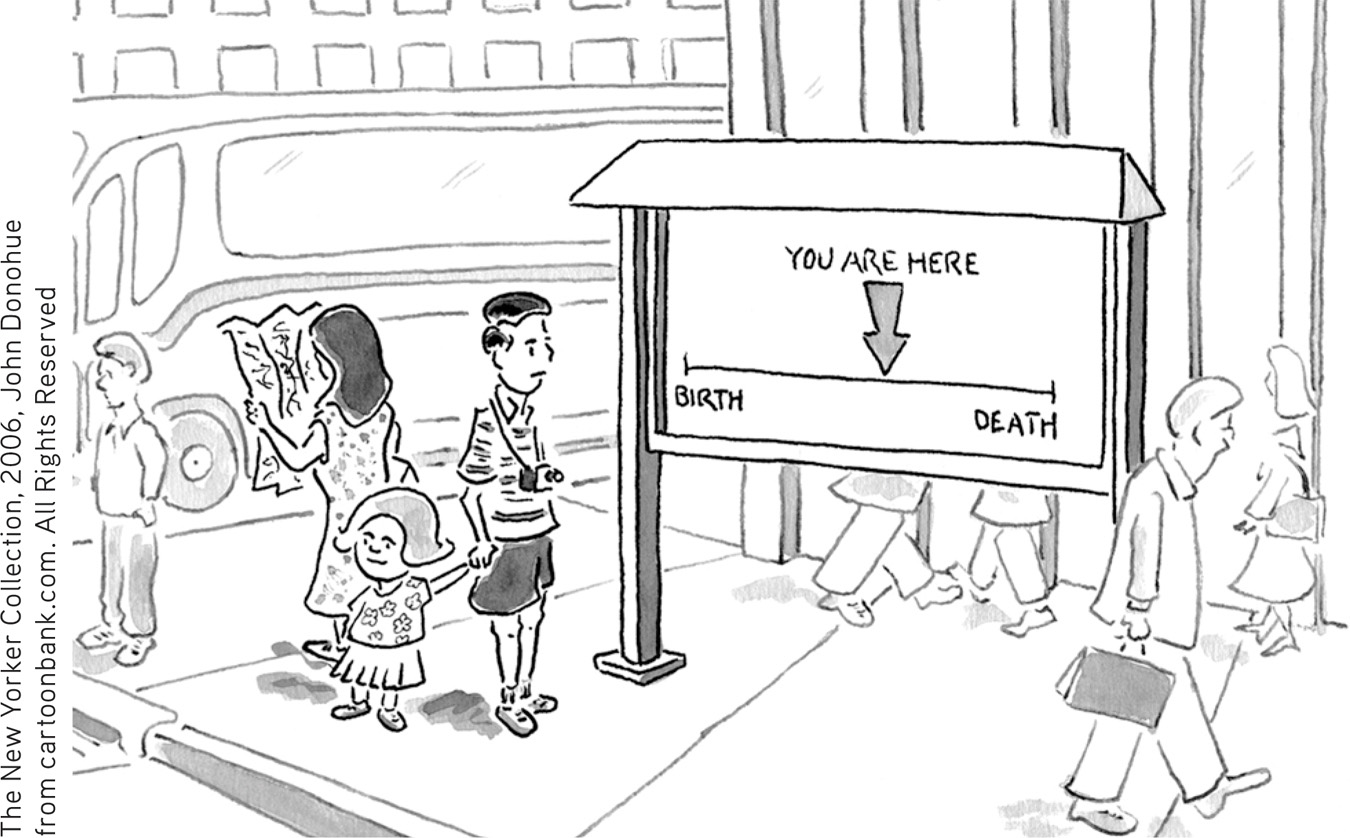
Love We typically flirt, fall in love, and commit—one person at a time. “Pair-bonding is a trademark of the human animal,” observed anthropologist Helen Fisher (1993). From an evolutionary perspective, relatively monogamous pairing makes sense: Parents who cooperated to nurture their children to maturity were more likely to have their genes passed along to posterity than were parents who didn’t.
Adult bonds of love are most satisfying and enduring when marked by a similarity of interests and values, a sharing of emotional and material support, and intimate self-disclosure. There also appears to be “vow power.” Straight and gay couples who seal their love with commitment—via marriage or other public vows—more often endure (Balsam et al., 2008; Rosenfeld, in press). Such bonds are especially likely to last when couples marry after age 20 and are well educated. Compared with their counterparts of 50 years ago, people in Western countries are better educated and marrying later. Yet, ironically, they are nearly twice as likely to divorce. (Both Canada and the United States now have about one divorce for every two marriages, and in Europe, divorce is only slightly less common.) The divorce rate partly reflects women’s lessened economic dependence and men and women’s rising expectations. We now hope not only for an enduring bond, but also for a mate who is a wage earner, caregiver, intimate friend, and warm and responsive lover.
221

Historically, couples have met at school, on the job, through family, or, especially, through friends. Since the advent of the Internet, such matchmaking has been supplemented by a striking rise in couples who meet online—as have nearly a quarter of heterosexual couples and some two-thirds of same-sex couples in one recent national survey (FIGURE 5.26).
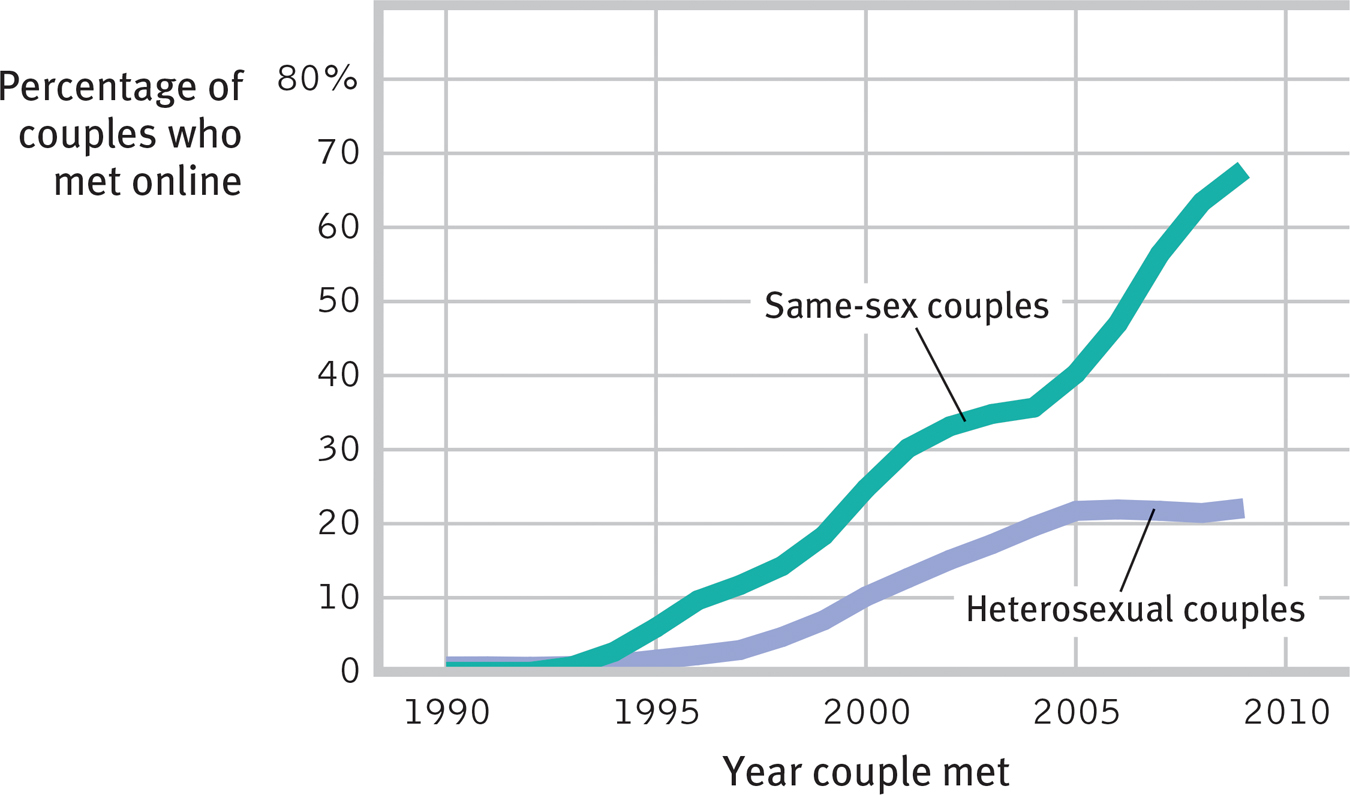
 Figure 5.26
Figure 5.26The changing way Americans meet their partners A national survey of 2452 straight couples and 462 gay and lesbian couples reveals the increasing role of the Internet. (Data from Rosenfeld, 2013; Rosenfeld & Thomas, 2012.)
Might test-driving life together in a “trial marriage” minimize divorce risk? In Europe, Canada, and the United States, those who cohabit before marriage have had higher rates of divorce and marital dysfunction than those who did not cohabit (Jose et al., 2010). In recent data, however, those who cohabited only after engagement and only with their future spouse did not have an increased divorce risk (Goodwin et al., 2010; Jose et al., 2010; Manning & Cohen, 2011; Stanley et al., 2010). American children born to cohabiting parents have been four to five times more likely to experience their parents’ separation than children born to married parents (Osborne et al., 2007; Smock & Manning, 2004). Two factors contribute. First, cohabiters tend to be initially less committed to the ideal of enduring marriage. Second, they may become even less marriage supporting while cohabiting.
Although there is more variety in relationships today, the institution of marriage endures. In Western countries, people marry for love. What counts as a “very important” reason to marry? Among Americans, 31 percent say financial stability, and 93 percent say love (Cohn, 2013). And marriage is a predictor of happiness, sexual satisfaction, income, and physical and mental health (Scott et al., 2010). National Opinion Research Center surveys of more than 50,000 Americans since 1972 reveal that 40 percent of married adults, though only 23 percent of unmarried adults, have reported being “very happy.” Lesbian couples, too, have reported greater well-being than those single (Peplau & Fingerhut, 2007; Wayment & Peplau, 1995). Moreover, neighborhoods with high marriage rates typically have low rates of social pathologies such as crime, delinquency, and emotional disorders among children (Myers & Scanzoni, 2005).
What do you think? Does marriage correlate with happiness because marital support and intimacy breed happiness, because happy people more often marry and stay married, or both?
222
Relationships that last are not always devoid of conflict. Some couples fight but also shower each other with affection. Other couples never raise their voices yet also seldom praise each other or nuzzle. Both styles can last. After observing the interactions of 2000 couples, John Gottman (1994) reported one indicator of marital success: at least a five-to-one ratio of positive to negative interactions. Stable marriages provide five times more instances of smiling, touching, complimenting, and laughing than of sarcasm, criticism, and insults. So, if you want to predict which couples will stay together, don’t pay attention to how passionately they are in love. The pairs who make it are more often those who refrain from putting down their partners. To prevent a cancerous negativity, successful couples learn to fight fair (to state feelings without insulting) and to steer conflict away from chaos with comments like “I know it’s not your fault” or “I’ll just be quiet for a moment and listen.”
“Our love for children is so unlike any other human emotion. I fell in love with my babies so quickly and profoundly, almost completely independently of their particular qualities. And yet 20 years later I was (more or less) happy to see them go—I had to be happy to see them go. We are totally devoted to them when they are little and yet the most we can expect in return when they grow up is that they regard us with bemused and tolerant affection.”
Developmental psychologist Alison Gopnik, “The Supreme Infant,” 2010
Often, love bears children. For most people, this most enduring of life changes is a happy event—one that adds meaning and joy (Nelson et al., 2013). “I feel an overwhelming love for my children unlike anything I feel for anyone else,” said 93 percent of American mothers in a national survey (Erickson & Aird, 2005). Many fathers feel the same. A few weeks after the birth of my first child I was suddenly struck by a realization: “So this is how my parents felt about me!”
When children begin to absorb time, money, and emotional energy, satisfaction with the relationship itself may decline (Doss et al., 2009). This is especially likely among employed women who, more than they expected, may carry the traditional burden of doing the chores at home. Putting effort into creating an equitable relationship can thus pay double dividends: greater satisfaction, which breeds better parent–child relations (Erel & Burman, 1995).
“To understand your parents’ love, bear your own children.”
Chinese proverb
Although love bears children, children eventually leave home. This departure is a significant and sometimes difficult event. For most people, however, an empty nest is a happy place (Adelmann et al., 1989; Gorchoff et al., 2008). Many parents experience a “postlaunch honeymoon,” especially if they maintain close relationships with their children (White & Edwards, 1990). As Daniel Gilbert (2006) has said, “The only known symptom of ‘empty nest syndrome’ is increased smiling.”
Work For many adults, the answer to “Who are you?” depends a great deal on the answer to “What do you do?” For women and men, choosing a career path is difficult, especially during bad economic times. Even in the best of times, few students in their first two years of college or university can predict their later careers.
For more on work, including discovering your own strengths, see Appendix A: Psychology at Work.
In the end, happiness is about having work that fits your interests and provides you with a sense of competence and accomplishment. It is having a close, supportive companion who cheers your accomplishments (Gable et al., 2006). And for some, it includes having children who love you and whom you love and feel proud of.

223
RETRIEVAL PRACTICE
- Freud defined the healthy adult as one who is able to ______________ and to ______________.
love; work
Well-Being Across the Life Span
5-21 How does our well-being change across the life span?
To live is to grow older. This moment marks the oldest you have ever been and the youngest you will henceforth be. That means we all can look back with satisfaction or regret, and forward with hope or dread. When asked what they would have done differently if they could relive their lives, people’s most common answer has been “taken my education more seriously and worked harder at it” (Kinnier & Metha, 1989; Roese & Summerville, 2005). Other regrets—“I should have told my father I loved him,” “I regret that I never went to Europe”—have also focused less on mistakes made than on the things one failed to do (Gilovich & Medvec, 1995).
“When you were born, you cried and the world rejoiced. Live your life in a manner so that when you die the world cries and you rejoice.”
Native American proverb
From the teens to midlife, people typically experience a strengthening sense of identity, confidence, and self-esteem (Huang, 2010; Robins & Trzesniewski, 2005). In later life, challenges arise: Income shrinks, work is often taken away, the body deteriorates, recall fades, energy wanes, family members and friends die or move away, and the great enemy, death, looms ever closer. And for those in the terminal decline phase, life satisfaction does decline as death approaches (Gerstorf et al., 2008).
“Hope I die before I get old.”
Pete Townshend, of the Who (written at age 20)
Small wonder that most presume that happiness declines in later life (Lacey et al., 2006). But worldwide, as Gallup researchers discovered, most find that the over-65 years are not notably unhappy (FIGURE 5.27). Self-esteem remains stable (Wagner et al., 2013). If anything, positive feelings, supported by enhanced emotional control, grow after midlife and negative feelings subside (Stone et al., 2010; Urry & Gross, 2010). Older adults increasingly use words that convey positive emotions (Pennebaker & Stone, 2003), and they attend less and less to negative information. Compared with younger adults, for example, they are slower to perceive negative faces and more attentive to positive news (Isaacowitz, 2012; Scheibe & Carstensen, 2010).

 Figure 5.27
Figure 5.27Nelson Mandela embodied stable life satisfaction The Gallup Organization asked 658,038 people worldwide to rate their lives on a ladder from 0 (“the worst possible life”) to 10 (“the best possible life”). Age gave no clue to life satisfaction. (Data from Morrison et al., 2014.)
“Still married after all these years?
No mystery.
We are each other’s habit, And each other’s history.”
Judith Viorst, “The Secret of Staying Married,” 2007
Compared with teens and young adults, older adults also have a smaller social network, with fewer friendships (Wrzus et al., 2012). Like people of all ages, older adults are, however, happiest when not alone (FIGURE 5.28 below). They also experience fewer problems in their relationships—less attachment anxiety, stress, and anger (Chopik et al., 2013; Fingerman & Charles, 2010; Stone et al., 2010). With age, we become more stable and more accepting (Carstensen et al., 2011; Shallcross et al., 2013).
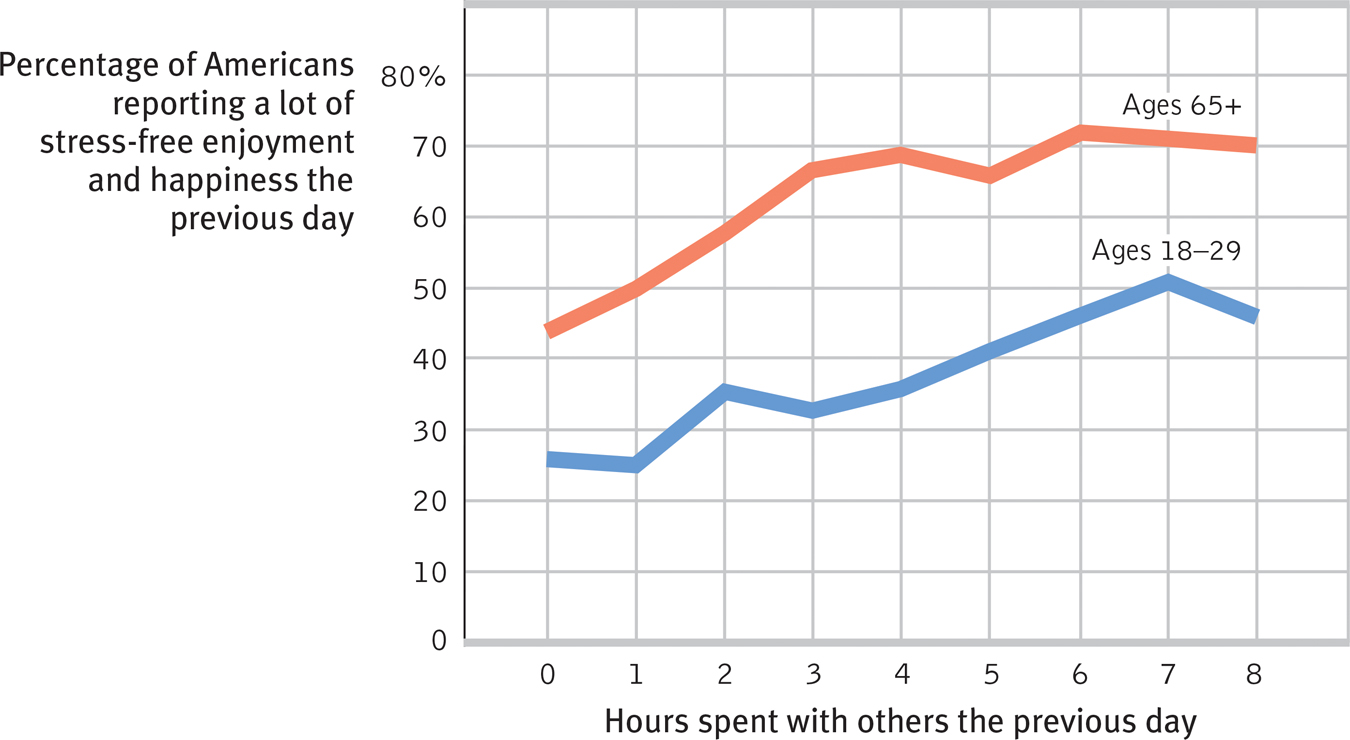
 Figure 5.28
Figure 5.28Humans are social creatures Both younger and older adults report greater happiness when spending time with others. (Note, this correlation could also reflect happier people being more social.) (Gallup survey data reported by Crabtree, 2011.)
224
The aging brain may help nurture these positive feelings. Brain scans of older adults show that the amygdala, a neural processing center for emotions, responds less actively to negative events (but not to positive events) (Mather et al., 2004). Brain-wave reactions to negative images also diminish with age (Kisley et al., 2007).
“At 20 we worry about what others think of us. At 40 we don’t care what others think of us. At 60 we discover they haven’t been thinking about us at all.”
Anonymous
Moreover, at all ages, the bad feelings we associate with negative events fade faster than do the good feelings we associate with positive events (Walker et al., 2003). This contributes to most older people’s sense that life, on balance, has been mostly good. Given that growing older is an outcome of living (an outcome most prefer to early dying), the positivity of later life is comforting. Thanks to biological, psychological, and social-cultural influences, more and more people flourish into later life (FIGURE 5.29).
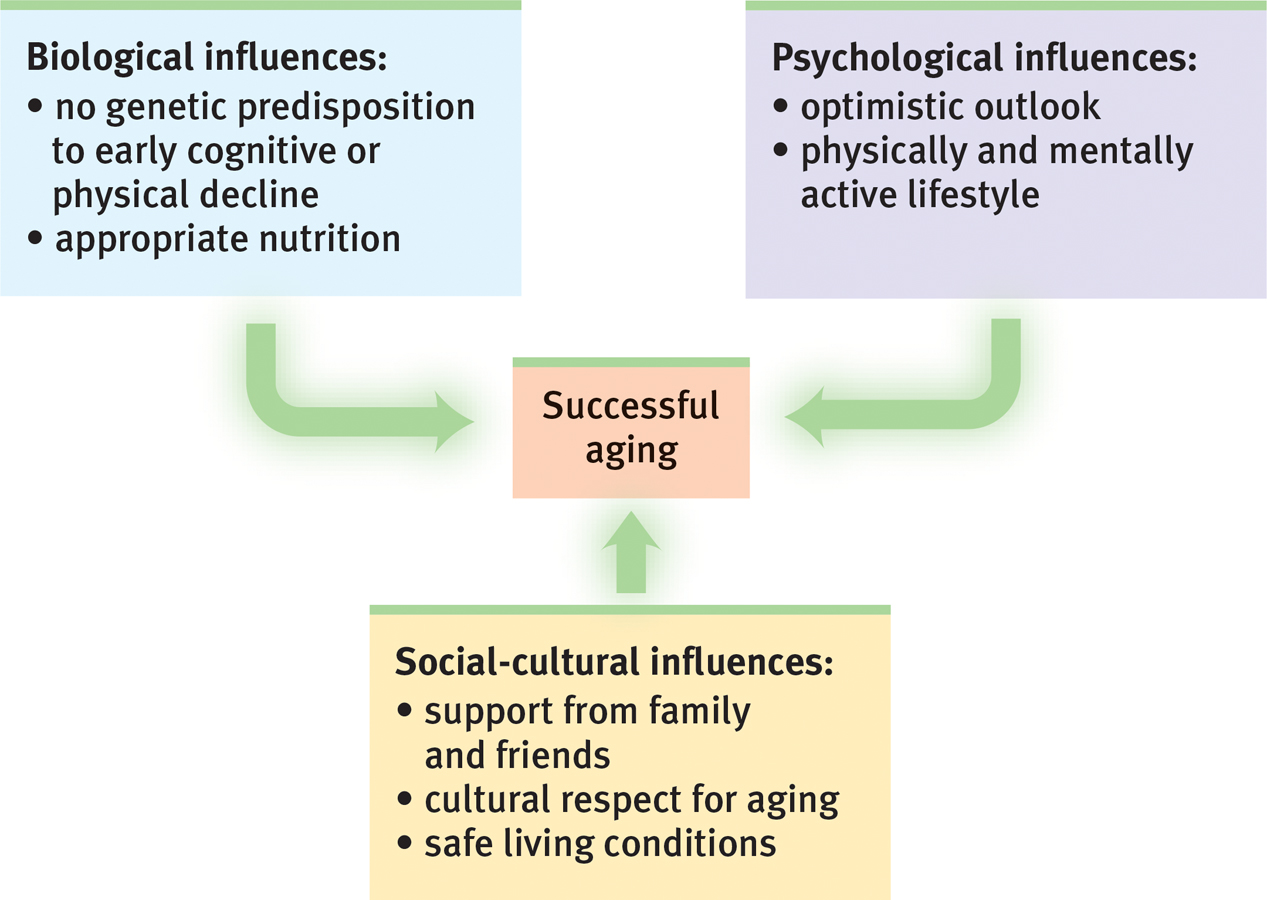
 Figure 5.29
Figure 5.29Biopsychosocial influences on successful aging
The resilience of well-being across the life span obscures some interesting age-related emotional differences. Psychologists Mihaly Csikszentmihalyi [chick-SENT-me-hi] and Reed Larson (1984) mapped people’s emotional terrain by periodically signaling them with electronic beepers to report their current activities and feelings. They found that teenagers typically come down from elation or up from gloom in less than an hour, but adult moods are less extreme and more enduring. As the years go by, feelings mellow (Costa et al., 1987; Diener et al., 1986). Highs become less high, lows less low. Compliments provoke less elation and criticisms less despair, as both become merely additional feedback atop a mountain of accumulated praise and blame. As we age, life therefore becomes less of an emotional roller coaster.
“The best thing about being 100 is no peer pressure.”
Lewis W. Kuester, 2005, on turning 100
225
RETRIEVAL PRACTICE
- What are some of the most significant challenges and rewards of growing old?
Challenges: decline of muscular strength, reaction times, stamina, sensory keenness, cardiac output, and immune system functioning. Risk of cognitive decline increases. Rewards: positive feelings tend to grow, negative emotions are less intense, and anger, stress, worry, and social-relationship problems decrease.
Death and Dying
5-22 A loved one’s death triggers what range of reactions?
Warning: If you begin reading the next paragraph, you will die.
“Love—why, I’ll tell you what love is: It’s you at 75 and her at 71, each of you listening for the other’s step in the next room, each afraid that a sudden silence, a sudden cry, could mean a lifetime’s talk is over.”
Brian Moore, The Luck of Ginger Coffey, 1960
But of course, if you hadn’t read this, you would still die in due time. “Time is a great teacher,” noted the nineteenth-century composer Hector Berlioz, “but unfortunately it kills all its pupils.” Death is our inevitable end. We enter the world with a wail, and usually leave it in silence.
Most of us will also suffer and cope with the deaths of relatives and friends. Usually, the most difficult separation is from one’s partner—a loss suffered by five times more women than men. Grief is especially severe when a loved one’s death comes suddenly and before its expected time on the social clock. The sudden illness or accident claiming a 45-year-old life partner or a child may trigger a year or more of memory-laden mourning that eventually subsides to a mild depression (Lehman et al., 1987).
For some, however, the loss is unbearable. One Danish long-term study of more than 1 million people found that about 17,000 of them had suffered the death of a child under 18. In the five years following that death, 3 percent of them had a first psychiatric hospitalization, a 67 percent higher rate than among other parents (Li et al., 2005).
Even so, reactions to a loved one’s death range more widely than most suppose. Some cultures encourage public weeping and wailing; others hide grief. Within any culture, individuals differ. Given similar losses, some people grieve hard and long, others less so (Ott et al., 2007). Contrary to popular misconceptions, however,
- terminally ill and bereaved people do not go through identical predictable stages, such as denial before anger (Friedman & James, 2008; Nolen-Hoeksema & Larson, 1999).
- those who express the strongest grief immediately do not purge their grief more quickly (Bonanno & Kaltman, 1999; Wortman & Silver, 1989). On the other hand, grieving parents who try to protect their partner by “staying strong” and not discussing their child’s death may actually prolong the grieving (Stroebe et al., 2013).
- bereavement therapy and self-help groups offer support, but there is similar healing power in the passing of time, the support of friends, and the act of giving support and help to others (Baddeley & Singer, 2009; Brown et al., 2008; Neimeyer & Currier, 2009). Grieving spouses who talk often with others or receive grief counseling adjust about as well as those who grieve more privately (Bonanno, 2004; Stroebe et al., 2005).
“Consider, friend, as you pass by, as you are now, so once was I. As I am now, you too shall be. Prepare, therefore, to follow me.”
Scottish tombstone epitaph
Facing death with dignity and openness helps people complete the life cycle with a sense of life’s meaningfulness and unity—the sense that their existence has been good and that life and death are parts of an ongoing cycle. Although death may be unwelcome, life itself can be affirmed even at death. This is especially so for people who review their lives not with despair but with what Erik Erikson called a sense of integrity—a feeling that one’s life has been meaningful and worthwhile.
226
REVIEW: Adulthood

|
REVIEW | Adulthood |
LEARNING OBJECTIVES
RETRIEVAL PRACTICE Take a moment to answer each of these Learning Objective Questions (repeated here from within this section). Then click the 'show answer' button to check your answers. Research suggests that trying to answer these questions on your own will improve your long-term retention (McDaniel et al., 2009).
5-17 What physical changes occur during middle and late adulthood?
Muscular strength, reaction time, sensory abilities, and cardiac output begin to decline in the late twenties and continue to decline throughout middle adulthood (roughly age 40 to 65) and late adulthood (the years after 65). Women’s period of fertility ends with menopause around age 50; men have no similar age-related sharp drop in hormone levels or fertility. In late adulthood, the immune system weakens, increasing susceptibility to life-threatening illnesses. Chromosome tips (telomeres) wear down, reducing the chances of normal genetic replication. But for some, longevity-supporting genes, low stress, and good health habits enable better health in later life.
5-18 How does memory change with age?
As the years pass, recall begins to decline, especially for meaningless information, but recognition memory remains strong. Older adults rely more on time management and memory cues to remember time-based and habitual tasks. Developmental researchers study age-related changes such as in memory with cross-sectional studies (comparing people of different ages) and longitudinal studies (retesting the same people over a period of years). “Terminal decline” describes the cognitive decline in the final few years of life.
5-19 How do neurocognitive disorders and Alzheimer’s disease affect cognitive ability?
Neurocognitive disorders (NCDs) are acquired (not lifelong) disorders marked by cognitive deficits, which are often related to Alzheimer’s disease, brain injury or disease, or substance abuse. This damage to brain cells results in the erosion of mental abilities that is not typical of normal aging. Alzheimer’s disease is marked by neural plaques, often with an onset after age 80, entailing a progressive decline in memory and other cognitive abilities.
5-20 What themes and influences mark our social journey from early adulthood to death?
Adults do not progress through an orderly sequence of age-related social stages. Chance events can determine life choices. The social clock is a culture’s preferred timing for social events, such as marriage, parenthood, and retirement. Adulthood’s dominant themes are love and work, which Erikson called intimacy and generativity.
5-21 How does our well-being change across the life span?
Self-confidence tends to strengthen across the life span. Surveys show that life satisfaction is unrelated to age. Positive emotions increase after midlife and negative ones decrease.
5-22 A loved one’s death triggers what range of reactions?
People do not grieve in predictable stages, as was once supposed. Strong expressions of emotion do not purge grief, and bereavement therapy is not significantly more effective than grieving without such aid. Erikson viewed the late-adulthood psychosocial task as developing a sense of integrity (versus despair).
TERMS AND CONCEPTS TO REMEMBER
RETRIEVAL PRACTICE Match each of the terms on the left with its definition on the right. Click on the term first and then click on the matching definition. As you match them correctly they will move to the bottom of the activity.
Question
wPFEoJRUic+Y/S5hG+DFR8Kwd73aS+Z3dr1U/1csSrF7LeAzUbprSXkGDTRF8ocHYljtEJYn2rkap/57UvP4Eb2zjT93huJ20LTq3BBkML/Lkxqx8KSUpnVshW8+I35CbDoeZR+qsnn/hlDaNMidSsyeh08CpVmhbGYw0d0Onu6DOVlrPfJDMf89YwwKHMRZN31NTvn03ysbOsWJQuwbp334Peazvh53SoL5XGfR31tAWk1ccg5Hb+2Jkga7tGkc0qUEqEOOBAlhj+RdSV3OUlJBpFmSjOt1U7C8s9b42xjKSZISE2UMpIQHUMH6wUkA62e2HzkaWbA+uv4072JZIzMG0Nz7WyVRNsE7jgQl8m6u2/Cs0OVDimsz/PNQCfYrxTycKuglJbX0QeZ9JTqZCxs9Iy3GXOXMPS9frXeo3DjnaD7DeeF3ED5VPn/pTvBqcqHT8QVPMOzkx54q7M6nEpTgRojC8+m4HU1hTy3Io9WTtYW/y0VNfQkwg3QSCmOCZwzZVJFXQ1lgp+99eWop6bjaC64H7FMJSl5iq/zNiUWFxfUkxZOoGW5+lnzx4odLNhGa0ZbDOqbAV/14ijl+04+OO+x43vWMMQEnx/GXo1KU0wb6ZDEFY1m5G5dh+qfC4YqMqcKgpx1hALIxIiHF61WUwyRkbSO68PwLKJXakjdvYoJs0BGiyaVWzUxp0oHdly6VgJIYnQxZjsFRU/PjR4tdieX9LTlXISTvta2Gx5WIOykGNkeaYasjXZscLpTiKUYQ4OcDMJxHVHqo+lIaeqq44SQjvVxpCYjKVOqIWybsSVkngunUA+RN2H6UlaASinNjTfcTGHgEHI4akQXXHBeJm1mKlb9/PiOcXwlGqQbcIUifk81qeaIC1U+8yhcCic+eqAj51MRKCTy6jWja/8T3Y4FqIiHkfeoMjAwxnlz1yzVtaGz6q0oTpcjVh8ZTmej+vcjlskcQcWohL2ErADiPvYqZZ7xDzBCBBPejNOGdZof/qvdvGQ9GYUUTfNMtDFMl66Nbdj+9kUiZCbEx5wDckg56uQil4qIbmT3YiyIY1ENHFRicGklxhoq6MyqJFU4ZUxlOtmisZNbJmxL8cnQVX+Y82lYUPEPyGuVfl5DKtd/eaGvzPvkw2yX2wXZCL5KgM/hSAfr2qWCGwYFvzY6fOI90l3d19ZkSN97d5uMhsVhGf7dxBQCgSsDp/A+/V+/uyZvbitvat6PdUse  to create your personalized study plan, which will direct you to the resources that will help you most in
to create your personalized study plan, which will direct you to the resources that will help you most in  .
.
TEST
YOUR-
SELF DEVELOPING THROUGH THE LIFE SPAN
Test yourself repeatedly throughout your studies. This will not only help you figure out what you know and don’t know; the testing itself will help you learn and remember the information more effectively thanks to the testing effect.
 Developmental Issues, Prenatal Development, and the Newborn
Developmental Issues, Prenatal Development, and the Newborn
Question
1. The three major issues that interest developmental psychologists are nature/nurture, stability/change, and EQrXbmp2BRTVDKJmSh8NKA== hUoJ86+tCQe+gYKj .
Question
yVRcsrShhbZidwm9YyARcg6CdGP+1EXneJL0AvGlGb4GB09cOb2xL4gxjhmsBEuLrJu0RiIcCn2Zdg893gqxeHKYvyJE6dnOLGzbB/3XoAfevFA50SC7D8q96qek/cv2zJSyxgGJ6/xlHJ9DhgWSCIzguCp3CA7Y+xb5YWoVbs4h8ptMMV3pd95HUZEyP0FhvLVt2FLsxOq6oaqrDWnyW9z08nAyeFhLtXuSGR/XDfqhqnXOFQFCGQjRENblGSvSh/HQWBSWx/FSS7vqBB1plwZ1dk1fJz8HMB3nFwqmAFZFBCIRUAzJjtpGGNLWjUxCtP1jCpOA8oR2dE5ZrGYPZ3K0j8cxvWMpfz1Qn9R2bSsRAQrbWAb3yHYfiz8Jv8O/XAB5KLP0WQ1ySrAtMiiIsJP3CSlzC3zis3c2Pfj2nvPSzsgEuM0dTaSK0Gg8wt3PrleIx4u5CocVD9WJvCSYSsprnyLyvSvzZJpaA7Bv1GKQQB3FTRGs593IEb2HzHnO57gDnA==Question
M0jyMaHIDdZ+o0GFvLe1j/lWTwjYtA3ZPeSwyYh5vJMyP1K1UHIZOO+W7fMXXhcLBcRGYeRP9cLpfYv/GkXlRGYZqt/eBlRGg8bumhqY2++wl2rF+zz8r3G3GSC6wyAtL95HfYfS18w9bAzwJ4r/mf0RY3SWdux4+3hCyuV5elNgSraZkXm6pvmPNqV2tCE/m9xKt1MWwIE++alSfDBcpa2b9yh+eyCHe8BEWew841HceYXjLYPIE8s3CWhhzCrJ82jnnFWpftjp6yxL7fhxKz3x/zh9tT4nc7kJNU+Xo2bwM87kOFJG2/2uDD8AaGeLO4Izp3MfcJtw6w2R86qMQPMZOXGMMv8tzSoDJNFGryliAYShMbNs4f4Ns1JH9cetlBSGsAFbygAPLt6JOBJLs/zCsLcYikmjN4F+7T8cavKQEzOBQuestion
4. Chemicals that pass through the placenta’s screen and may harm an embryo or fetus are called HFAQ+T+6zn+M299chytQuw== .
 Infancy and Childhood
Infancy and Childhood
Question
Ka9FHq3w5YVBC9mjps3i2EKfJcNXAh4Mc8LIqJMcs/lITsoygJhar4o5Lab9SpUDrc1mHO90dBQzo5dE4anUiX4bx5JVewz9dnAUowvDrjCWoOhEYUQtlINsVyrDt/89HpUqiai/ZHq3cfOHxtmIUAuMXfKqeKj1+qnAU4BeMMT3/Y23zzsUcZ/H4hc6Xr1fB++WvZlR+IrGJDpSiQj8T9DR7Q+Yo/H7fi6Hib/Mk2jFB7yMRlpRalvIEn9vXky2Question
6. Between ages 3 and 6, the human brain experiences the greatest growth in the 94eFyu0V4Eufe7li lobes, which enable rational planning and aid memory.
Question
VSPd67OjI3Pgmu8ftELpl8iH6/JdEMSlS2Pyd3g/zpJJwxj73lwKDNp7y2scBCLOr8OOWMPfmBpjQhcSqd+7g6vtsrFVnoh8oUr1QrQZTftpUVmIqxfWxxeIIfWqXNxe7tcJU2TnXWh6vzDt/kR2/Cm9auLbKKhkqXKRQQQzwoMmNnXB+BklnQxZKmVJGerZM+uciyM5Z8CMh0N4m6My/XrmyoKaiCFwSQTFKmWtOUaUAk3Lhv1nTXt1hTLEtpJs595y9EQ7qkXy1hvHd6zoo6PvaGKF5czNRnSRsXbRmANiaEXz0tMplLMWTkkXLrw1M29VMWj/FAKJi/v8JLpPQI5DbBYKL1wsEAJsXpmuIOlt7QiOjGyyZVNysNKxrl2UVb8IMkYa982HK3jQrovm1IzOYmM=Question
IxO9Amn6cIUcwrq1sOfrTUVYzNjTg4ljo6bym5KDfeRYXk/9PhPCoDap8iErb4nhE7+5ChosGltruOFgD/Sp9PjIqVKU885D+c/OWcrdcA5+BaC75ucYHTxzuZCTLe3E6l4FVbMS/7g=We have no conscious memories of events occurring before about age 31/2, in part because major brain areas have not yet matured.
Question
zNQZTit0dXkIcQSMc4qgBVNBSsd5yX7ApYtgxG27iqhlMgMavJNy+cVPdlrUU0Xl5FJBpdCAkpm62wEOFdxmAYbN7jWCdSSFTEQj96FJ/XQ8+L0lacv3OhoNyTiBeB2Ta8L1MhX6OjissrnCE2pEVdexmABMCEw2uEa5QCZchQGeO1XZZOhTaSjrIBFNbgtUSSeQveysW4KFHW2uBjcu2fLe8Xk=Infants in Piaget’s sensorimotor stage tend to be focused only on their own perceptions of the world and may, for example, be unaware that objects continue to exist when unseen. A child in the preoperational stage is still egocentric and incapable of appreciating simple logic, such as the reversibility of operations. A preteen in the concrete operational stage is beginning to think logically about concrete events but not about abstract concepts.
227
Question
9eD8JHToMIJsLiIihZo1fVCErkJ7mESAvHYF2q8wAq78EX1jQqciOsSVTeV6vV/Go5gpQO2oSIJr/w/0of8Sgbg5NZOO5R6Ya5w6wcxtxkS3yQrZAOqUn4dgFxFwUAotLcPZs3dMKlcFaw3msa7Al+jk2Q4y0l3+Yfvw09CJ4iDOU9gAv8sLLtnMrK5AbZ3RPcFDLkoEM9dPTrwqONaSRxZUkqPCvAtrwLBTB4qRmU+xoyniRTs4iY1CM3O4wVYpR6rmN4ly02tf6So5mjqtwBMhFsJ+VyjyjtxGY9X1PFd34/8PjNLQsdpWquwCPyrlSHEMKgbpaZZVy1H1j26MwUZpUGDWPOeB6Ngpwqxl2OIuLiFGEM83G4HezmZl7Nxx/rPbmT9Qk5skxW4wK+6ixqhCSraBQwyLuWjDyuYjxazKpJ0xI7NUAjmncdWDbFyy/0RUr1g4CuTl7X1VJqnxp2tDtE2FSuBs+4hhV0lRKQP6HyTkJ+JRhgeR+ND2TYf97xcGa+0vfWKiHsgPMAqXkPUiFfYquwkeU70zz9hdmWkfGVdbeYSLnVEPWVjcpNezETCvnC8wl/UlLWWnZpN5W6+4D0A=Question
11. An 8-month-old infant who reacts to a new babysitter by crying and clinging to his father’s shoulder is showing V4wwD6Dzj7uQE6b1RpoaDA== UULgegGr1AUBt9No .
Question
605Qv57MFflJxggkKROIXV8pUsiuscngwNxvp+qV3CwU05jRkGpGzjG9wzEFcx5Zz6nBWDSJ/K+jWRAJIKjVlpiV7XqTUDL/cFq+pdikX8/g9EjPAmDbjlW1VxOBFmi97Gv2a+BAOauK27xqWbLQUPVwLto9jaGrIrLSfwRqy6+0BTZukxyh6sePZxdWcmjck9f9AXQG9LOJIVPD77R9ogQo9HO1fhkxIXxVSrQYnPpgC1cV2uyvDLlCfagdm+N9rv1ojH8WZ0TPr/cjQc4RVCE7LEztkEQ8Ej2DkJ+xb8zkBzP9SlCU3qhGLJlQXBWWmkvmBv6ajcjkHeYVggdn3w==Before these studies, many psychologists believed that infants became attached to those who nourished them.
 Adolescence
Adolescence
Question
BXPfdkf0XUIaT3Jleu1rPg/UfZGqOZaODPrVqDsgB4P4bDm98r/r4/q3h2/9dOhQnn7lmM48IDpUTZqy9eJ5P9PyJw3CymnZ7RrebQCzdhIFZC67YMRXO9iAaQCPtQCVGLecNdhm5/XmqU2lijOrHUN7nlbIKchV2EZ4VKjyjmIJB8k6Ihl3MTSEddMMROizzRd5WVSuRD00k5S+/5pbE3T0MYtT3PYbMPRK5w==Question
14. According to Piaget, a person who can think logically about abstractions is in the NVP5NbBiHEjMH1e3 IeuPeNU3wSqV+uqOtoeeZQ== stage.
Question
IH/OUX9mqnEl7QZglgLEQNeNmEI6KuvZGCH2XxqaioMFazArtcbNfUl2oZ9AY/U/f+VxRq3PN6c8R2QAy5PVucCHAoWuy7wH1Fu0yZXngOJnG7g/Rg8xNcVNiuA0Au91qJa0cjamjMiH4Qbsqu5Db2QMYfLZ9FEaNVWQqKP7pih1WbwF/mfHnQzPfgQD9urrTx5bI3mcbwyZXXatXk3H5A6OfdsKavLnNFBt51CWtbN+8gq/gCqo8FVEjTaNe1ePULrkFpqhAD8x2ZjXYvyfax1CxLPzg9/GfFO/5YC4jXRLuFrOuyOCjnMnnwrahEiqJ/04Phx2CXZHAVxP+4oyjw==Question
16. Some developmental psychologists now refer to the period that occurs in some Western cultures from age 18 to the mid-twenties and beyond (up to the time of full adult independence) as J4pvyt4FJXZSiRzrhE63HA== vPRfspuN77TPB75/wyLxZQ== .
 Adulthood
Adulthood
Question
dcN6OUoQwEu1JY8e7nnjfPvx3pKhNyTzAho4dG9X+Qb2zDwu0h2X9enbK2WSx/vrVobugZbBryMcUpZ7YfsBQQIbqYozvbf9vjKLcw7OG53AopQZYMeSaR/upDnwWpoWqV4TmzWft+XIJd/pZhFOVuo6OEfzYHmOqo7fPFlSdjh5PjGT0RSWrV1+Rn0nywwbe+MKrKLZS5b+DTwuCQf6PPk9APnWNP8AevZjnC4qQFk71ciAgsY51uiZurCm9kV+0NmxVJBOD7Dp25HNa4gEzKMSNdYzuqZ/ImZJUFUi4Qi2o3HnKjmaV45RAOoAgtQ93hKS1zg8Ec18bh9RdB1usA6VeLagQynrT4Pw/W3nxOTmMewNrh5ne+uLXbcHB6IEA+8iBPKcEHzsL82/BULlk1jWMEGnsN54YsOqFfHqJfmrhYJLqVze+zb32b04H4+oSuvQbEGpox9tGPN66mB5y+3yflWGF7PjQuestion
tPuBt6tV7X4uediNGdoyQuf+rP8Cexw9omnVG9cntYE6B0DKQ1ft0G1t0czvC5EnuqP+jqi8GcPN90BxtBEdIyXnaSdOsMM6ighBiIP32BE=Cross-sectional studies compare people of different ages. Longitudinal studies restudy and retest the same people over a long period of time.
Question
19. Freud defined the healthy adult as one who is able to love and work. Erikson agreed, observing that the adult struggles to attain intimacy and D1lXTXPQXLenrCDZyE+Z4sPzsb4= .